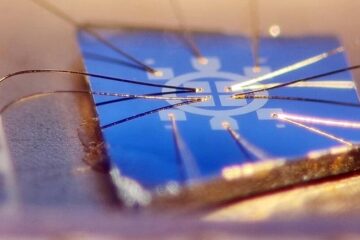Wind Against Fuel And Energy Crisis

Efficient and reliable construction of windmills has been developed by the specialists of the Open Joint-Stock Company Moscow Engineering Plant ’VPERED’. Even a single wind turbine like that can easily supply a country house or a cottage with electric power and hot water.
The windmill transforms the force of moderated wind into electric power, which supplies TV sets, teakettles, refrigerators and other household electric appliances with power, thus making life more convenient and comfortable.
Several new engineering solutions have been implemented in these outwardly ordinary wind turbines by the designers of the plant, the designers being professionals in the development and production of helicopter blades. Aluminium blades, the form of which has been thoroughly calculated, are installed on the four-sectional mast at the height of five meters. However, the mast can be lengthened if the house is located in a low place -additional sections are provided for this purpose.
The core of the windmill is a specially constructed magnetoelectric wind generator. At the wind velocity of about 7 meters per second, the generator produces the power of 550 Watt, and a special device (speed stabilizer) ensures that the output power is stable. Such wind – ranging between moderate and light breeze – is usual for the temperate climate zone. But in the middle latitudes the wind is a rather changeable factor: sometimes the wind is in place, sometimes it is so quiet, that a leaf would not stir, to say nothing of the wind turbine. Therefore, the designers have equipped the wind turbine, firstly with a wind orientation weathercock (so that the wind turbine turned towards the wind and could be used to the highest possible extent), and secondly, with electronic allocator of electric power.
Thanks to the allocator the energy is automatically distributed between the useful load and ballast load, and storage elements. If, for instance, less electric power is consumed than produced by the generator, then the excess is accumulated in storage batteries. These are common motor-car accumulators, there may be two or four of them, and they are installed inside or outside of the house in a metal case, the size of which is similar to that of bedside-table. Certainly, this is not a common case like the one where gas-cylinders are kept. This is a special moisture-proof frame equipped with LED displays to indicate the operating mode of the device.
In calm weather, the accumulated electricity is utilised, although power-consuming appliances like kettle can quickly consume the entire reserve. But the power reserve is sufficient to provide for light and to run a TV set, refrigerator and PC. As for the kettle, the water can be boiled by gas – normally there is a gas-cooker or an oven in a country house or a cottage.
When the wind is strong, particularly in case of a gale-strength wind, when more power is produced than can be consumed or stored, then the electronic circuit switches to the so-called ballast load. These are heating spirals which warm up the water, and, on top of that, prevent accumulators from freezing in wintertime. Besides, if the wind velocity is more than 8 meters per second, the wind turbine slightly bends to withstand the wind pressure and not to whirl in vain.
The new wind turbines are undergoing the final tests now. In the meantime, only pre-production models are in place, but soon, according to the manufactures estimates – as early as next year – the first FORWARD VEU-0.5 windmills (called so by the designers) will be available for sell. Since the device is reliably constructed of the same materials that are applied for aircraft building, the developers expect that it will be in use for long, for 12 to 15 years. However, the windmill needs lubrication and cleaning from time to time. In response, the windmill will provide electric power and confidence that the light will be available any time, regardless of the acts of storms (which can break the wire) or local authorities.
Media Contact
Weitere Informationen:
http://www.informnauka.ru/eng/2003/2003-01-28-02_302_e.htmAlle Nachrichten aus der Kategorie: Energie und Elektrotechnik
Dieser Fachbereich umfasst die Erzeugung, Übertragung und Umformung von Energie, die Effizienz von Energieerzeugung, Energieumwandlung, Energietransport und letztlich die Energienutzung.
Der innovations-report bietet Ihnen hierzu interessante Berichte und Artikel, unter anderem zu den Teilbereichen: Windenergie, Brennstoffzellen, Sonnenenergie, Erdwärme, Erdöl, Gas, Atomtechnik, Alternative Energie, Energieeinsparung, Fusionstechnologie, Wasserstofftechnik und Supraleittechnik.
Neueste Beiträge

Neue Industrie-4.0-Lösung für niedrigschwelligen Zugang zu Datenräumen
»Energizing a Sustainable Industry« – das Motto der Hannover Messe 2024 zeigt klar, wie wichtig eine gleichermaßen leistungsstarke und nachhaltige Industrie für den Fertigungsstandort Deutschland ist. Auf der Weltleitmesse der…

Quantenpräzision: Eine neue Art von Widerstand
Physikforschende der Universität Würzburg haben eine Methode entwickelt, die die Leistung von Quantenwiderstands-Normalen verbessern kann. Sie basiert auf einem Quantenphänomen namens anomaler Quanten-Hall-Effekt. In der industriellen Produktion oder in der…

Sicherheitslücke in Browser-Schnittstelle erlaubt Rechnerzugriff über Grafikkarte
Forschende der TU Graz waren über die Browser-Schnittstelle WebGPU mit drei verschiedenen Seitenkanal-Angriffen auf Grafikkarten erfolgreich. Die Angriffe gingen schnell genug, um bei normalem Surfverhalten zu gelingen. Moderne Websites stellen…





















